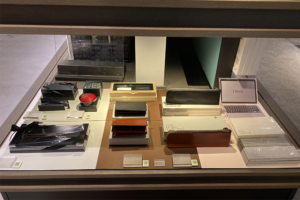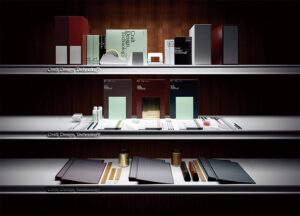Craft Design Technology
Craft design technology is a captivating field that marries traditional craftsmanship with cutting-edge technological advancements. It involves the use of advanced tools and techniques to create unique and innovative handcrafted products. In today’s fast-paced world, where automation reigns supreme, craft design technology has emerged as a breath of fresh air, preserving artistry and craftsmanship in the face of mass production. This article aims to delve deeper into the hidden artistic potential of craft design technology, exploring how it can not only enhance the creative process but also redefine the boundaries of what is possible in the realm of artistic expression.
While craft design technology may seem like a contradiction at first, it opens up endless possibilities for artistic exploration. By integrating digital tools like 3D modeling, laser cutting, and CNC machines with traditional crafts such as woodworking, pottery, and textile art, artists and designers can push the boundaries of their creativity. The precision and efficiency offered by technology allow artists to experiment more freely, enabling them to create intricate and complex designs that would have been difficult or time-consuming to achieve by hand alone. Moreover, craft design technology offers the advantage of reproducibility, enabling artists to produce multiple iterations of their work while preserving the uniqueness and individuality inherent in handcrafted art.
1. Understanding the Evolution of Craft Design Technology
2. Exploring the Intersection of Traditional Crafts and Digital Tools
3. Unleashing the Creativity: How Craft Design Technology Empowers Artists
4. The Advantages and Limitations of Craft Design Technology in Artistic Practice
5. Future Trends: The Exciting Possibilities of Craft Design Technology
1. Understanding the Evolution of Craft Design Technology
Craft design technology is a field that has experienced a significant evolution over the years, driven by advancements in technology and changing artistic trends. This section aims to provide an insight into the journey of craft design technology, from its early beginnings to its modern-day potential.
The roots of craft design technology can be traced back to ancient civilizations, where artisans employed various techniques to create intricate and aesthetically pleasing artworks. In these early times, craftsmen relied on traditional methods such as hand carving, weaving, and pottery to create their masterpieces. The process was labor-intensive and often required years of apprenticeship to master.
The next major leap in craft design technology came with the advent of the Industrial Revolution in the 18th century. The introduction of machinery and mass production techniques revolutionized the field, making it possible to produce intricate designs at a much faster rate. However, this era also marked a decline in the appreciation for handcrafted goods, as mass-produced items became more affordable and accessible.
In the 20th century, the rise of modernism and the Arts and Crafts movement brought a renewed interest in handmade craft design. Artisans began to combine traditional craftsmanship with modern techniques, resulting in innovative and unique creations. Artists such as William Morris and Frank Lloyd Wright played a significant role in popularizing the idea of integrating art with craft, leading to a renaissance in the field.
The digital age, which began in the late 20th century, brought about yet another significant evolution in craft design technology. The advent of computer-aided design (CAD) tools revolutionized the way craftsmen design and create their works. The ability to create precise virtual models and simulate various materials and textures opened up a whole new world of possibilities.
Today, craft design technology encompasses a wide range of tools and techniques, including 3D printing, laser cutting, computer-controlled machining, and virtual reality. These technologies have not only enhanced the creative process but also made it more accessible to a broader audience. Artists and designers can now experiment with complex designs, intricate patterns, and novel materials with ease.
Moreover, craft design technology has also found its way into interdisciplinary collaborations. Artists, architects, engineers, and scientists are coming together to explore the boundaries of creativity. For example, designers are using 3D printing to create jewelry, furniture, and personalized fashion accessories. Architects are incorporating parametric design techniques into the construction of buildings, resulting in stunning structures that were once unimaginable.
Craft design technology has undoubtedly come a long way, continuously evolving and adapting to the needs of the ever-changing artistic landscape. With each technological advancement, new doors are opened, allowing artists and designers to push the boundaries of their imagination further. As we move into the future, it is exciting to contemplate what possibilities lie ahead for the field of craft design technology. The potential for creating breathtaking and groundbreaking artistic expressions seems unlimited, only limited by the human imagination itself.

2. Exploring the Intersection of Traditional Crafts and Digital Tools
In recent years, a captivating convergence has taken place between traditional crafts and digital tools. This intriguing intersection has given birth to an exciting new field within design and art known as Craft Design Technology. Combining the timeless beauty of handmade craftsmanship with the limitless possibilities of technology, this fusion is unleashing a world of untapped artistic potential.
Traditionally, crafts have been intertwined with culture, history, and personal expression. Meticulously woven tapestries, delicately hand-carved sculptures, and exquisitely painted ceramics have all held a significant place in human creativity. These crafts represent a connection to our past and the artistry of skilled craftsmen. However, with the advent of digital tools, the landscape of crafting has been dramatically altered.
Digital tools and technologies have transformed the creative processes, offering artists and designers a new set of tools to further explore and exploit their craft. These tools enable creators to incorporate innovative techniques, complex algorithms, and intricate patterns into their work. For instance, 3D printing has revolutionized the production of ceramics, allowing artists to create intricate and customized designs that were once unimaginable. Digital embroidery machines have made it possible to effortlessly stitch elaborate patterns onto fabric, blurring the lines between traditional craftsmanship and technology.
One of the most prominent examples of the convergence between traditional crafts and digital tools is seen in the world of fashion. Fashion designers have long embraced traditional techniques such as embroidery, knitting, and weaving. However, with the advent of digital tools, they can now take their creations to new heights. Digital modeling software allows designers to experiment with various fabric drapes and silhouettes, enabling them to visualize their designs in a virtual 3D space. This not only saves time during the design process but also allows for more accurate and precise tailoring.
Another area where the intersection of traditional crafts and digital tools is making waves is in furniture design. Crafts such as woodworking and metalworking have always been at the forefront of furniture production. However, with the integration of digital tools, artisans can now seamlessly merge traditional craftsmanship with computer-aided design (CAD) software. This synergy allows for more intricate and innovative furniture designs that push the boundaries of what was previously thought possible.
The intersection of traditional crafts and digital tools is not limited to the realm of professional artists and designers. It has also found its way into the world of hobbyists, enthusiasts, and do-it-yourselfers. Online platforms and communities dedicated to craft design and technology have flourished, enabling individuals to learn and share their knowledge and skills. This democratization of craft design technology has empowered people to explore their creativity and embark on their own artistic journeys, blurring the lines between amateur and professional.
3. Unleashing the Creativity: How Craft Design Technology Empowers Artists
Craft design technology has emerged as a powerful tool that empowers artists, allowing them to unleash their creativity like never before. By merging traditional craftsmanship with cutting-edge technology, craft design technology has opened up a realm of possibilities for artists to express their ideas and create awe-inspiring works of art. In this section, we will explore the various ways in which craft design technology empowers artists.
First and foremost, craft design technology provides artists with a toolset that pushes the boundaries of traditional craftsmanship. In the past, artists were limited by their manual skills and tools, which often restricted their ability to materialize their wildest ideas. However, with the advent of craft design technology, artists can seamlessly blend traditional craftsmanship with digital techniques. This integration enables them to explore new forms, experiment with materials, and create intricate designs that were once unimaginable. Craft design technology becomes an extension of their creative process, enabling them to transcend the limitations of physical tools and enter a realm of infinite possibilities.
Furthermore, craft design technology simplifies complex processes, making them more accessible to artists. Traditionally, certain crafts required years of training and skill development to master. With craft design technology, however, artists can utilize software programs and machines that automate intricate processes, significantly reducing the learning curve and unlocking new levels of creativity. For example, 3D printers allow artists to transform their digital designs into physical objects effortlessly. This not only saves time but also encourages artists to push the boundaries of their craft, knowing that their ideas can be transformed into tangible works of art with relative ease.
Another aspect in which craft design technology empowers artists is by fostering collaboration and cross-disciplinary partnerships. Through online platforms and communities, artists can connect with like-minded individuals from across the globe, sharing ideas, knowledge, and techniques. This collaborative spirit facilitates the exchange of ideas and innovation, enabling artists to learn from each other and further expand their creative horizons. Craft design technology serves as a common language that bridges the gaps between various artistic disciplines, leading to the development of hybrid art forms that push the boundaries of creativity.
Moreover, craft design technology democratizes the artistic process, making it accessible to a broader audience. In the past, the cost of materials and tools often limited artistic expression to a privileged few. However, with craft design technology, artists can create digital designs that can be freely shared and accessed by anyone with a computer. This opens up the possibility of crowd-sourced art projects, where artists from different backgrounds and skill levels can contribute their ideas and collaborate on a masterpiece. Craft design technology has the ability to elevate art from a privileged domain to a collective and inclusive experience, where everyone can participate and contribute their unique perspective.
4. The Advantages and Limitations of Craft Design Technology in Artistic Practice
Craft design technology has increasingly become a valuable tool for artists, offering a range of advantages that can enhance their creative process and expand the possibilities for artistic expression. However, it is important to acknowledge that like any tool, craft design technology also has its limitations, and understanding both its advantages and limitations is crucial for artists seeking to explore its artistic potential fully.
One of the notable advantages of craft design technology in artistic practice is its ability to streamline the production process. With the aid of advanced computer software and machinery, artists can bring their ideas to life more efficiently, saving time and effort. The precision and accuracy achieved through these technologies allow for the creation of intricate and complex designs that might be difficult or impossible to achieve solely by hand. This not only enhances the artist’s ability to produce high-quality work but also opens up avenues for experimentation and innovation.
Moreover, craft design technology enables artists to push the boundaries of their artistic practice. By integrating digital tools into their creative process, artists can merge traditional techniques with cutting-edge technologies, resulting in unique and intriguing artworks. The integration of 3D printing, laser cutting, and CNC machining, among others, allows artists to create sculptures, installations, and even wearable art pieces that transcend traditional boundaries and challenge viewers’ perceptions.
Another significant advantage of craft design technology is its capacity to foster collaborations and community engagement. Through open-source platforms and online communities, artists can share their designs, techniques, and ideas, encouraging dialogue and cooperation among creators. This collaborative environment enables artists to learn from one another, inspire new approaches, and collectively advance their artistic practice. Artistic projects that were once limited to individual studios can now benefit from the wisdom and expertise of a broader artistic community, ultimately enriching the final artwork.
However, it is important to note that craft design technology also has its limitations. One major limitation is the potential detachment from the tactile experience of traditional craftsmanship. The physicality and tactile nature of traditional craft practices are often valued by artists for the intimate connection they establish with the materials. The use of technology can distance artists from this hands-on experience, potentially altering the creative process and aesthetic outcomes.
Furthermore, the initial cost and learning curve associated with craft design technology may present substantial barriers for many artists. Acquiring the necessary equipment, software, and skills to utilize these technologies effectively can require significant investment and time. This may restrict access to craft design technology to artists with the financial means or technical expertise, potentially excluding those from marginalized communities or with limited resources. The democratization of craft design technology remains an ongoing challenge that needs to be addressed to ensure equal opportunities for all artists.
5. Future Trends: The Exciting Possibilities of Craft Design Technology
As we delve deeper into the world of craft design technology, it is becoming evident that this field holds immense potential for the future. The fusion of traditional craftsmanship with modern technological advancements has paved the way for exciting possibilities that can revolutionize the way we create and appreciate art. In this section, we will explore some of the most promising trends that are emerging in the realm of craft design technology.
One of the most captivating trends is the integration of digital fabrication techniques with craft design. Traditional craftsmanship often involves time-consuming and meticulous manual work, but with the aid of digital tools, artists can now streamline and enhance their creative process. Technologies such as 3D printing and CNC machining allow for faster and more precise production of intricate designs, enabling artists to push the boundaries of what was previously possible. This convergence of handcrafted artistry and digital accuracy offers tremendous potential for creating one-of-a-kind pieces that blend the best of both worlds.
Furthermore, the advent of virtual reality (VR) and augmented reality (AR) has opened up new dimensions in which craft design can flourish. Artists are now able to immerse themselves in virtual environments, creating and manipulating designs in ways that were unimaginable before. VR not only offers a new level of interactivity but also provides artists with the opportunity to share their work with a global audience through virtual exhibitions and galleries. AR, on the other hand, allows artists to overlay digital information onto physical objects, creating dynamic and interactive experiences for viewers. The combination of VR and AR with craft design holds immense potential for pushing the boundaries of how we perceive and engage with art.
Another exciting trend in craft design technology is the integration of smart materials and wearable technology. Artists are exploring the incorporation of electronics, sensors, and interactive elements into their creations, transforming them into living artworks. Smart materials, such as shape-memory alloys and conductive textiles, allow for a dynamic and adaptive aesthetic experience, blurring the line between art and technology. Wearable technology, on the other hand, opens up new possibilities for interactive art forms that respond to the wearer’s movements and gestures. These developments have the potential to create a new genre of art that not only captivates the visual senses but also engages with the audience on a deeply personal and interactive level.
Furthermore, the rise of sustainable and environmentally conscious practices in craft design technology is a trend to watch. Artists are increasingly incorporating recycled materials, renewable energy sources, and sustainable production methods into their creative process. This shift towards eco-friendly practices not only promotes responsible consumption but also challenges artists to think creatively about their materials and processes, leading to innovative and thought-provoking art pieces.
Conclusion:
The future of craft design technology looks incredibly promising. The convergence of traditional craftsmanship with modern technological advancements allows for exciting possibilities that were once unimaginable. From the integration of digital fabrication techniques to the immersive experiences offered by virtual and augmented reality, and the incorporation of smart materials and wearable technology, artists are pushing the boundaries of artistry and creativity in ways we have yet to fully explore. Moreover, the growing emphasis on sustainability and eco-conscious practices in craft design technology is not only encouraging responsible consumption but also fostering innovative approaches to creating art. As we move forward, we can expect to witness a new era of artistic expression that blends the best of human craftsmanship with the power of technology.

